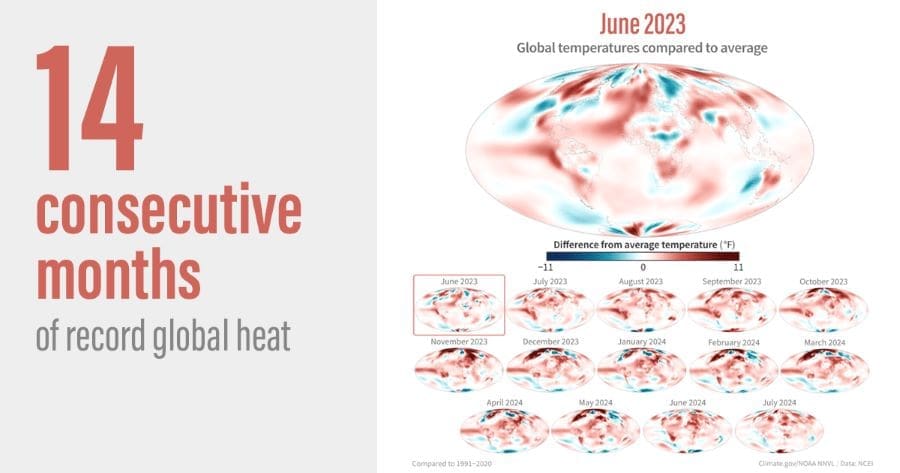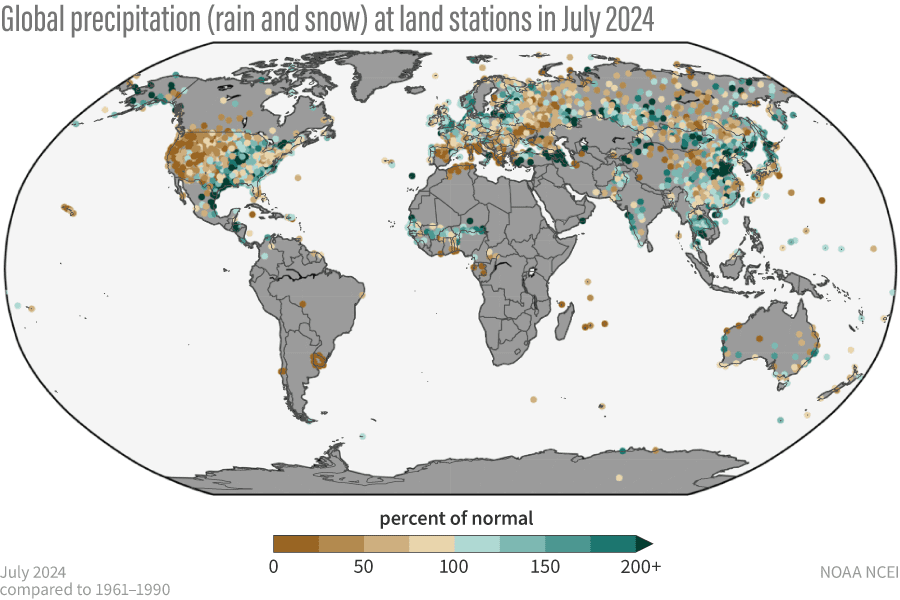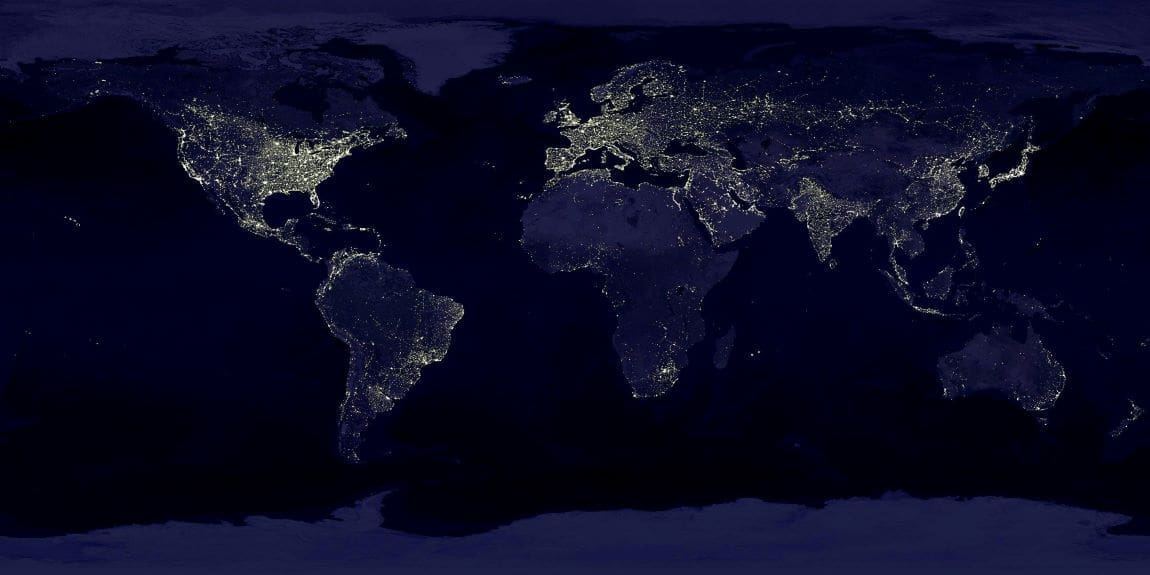July 2024 has officially become the warmest July ever recorded globally, according to data released by NOAA. The global surface temperature for the month was 1.21°C (2.18°F) above the 20th-century average of 15.8°C (60.4°F), surpassing the previous record set in July 2023 by 0.03°C (0.05°F).
This milestone also marks the 14th consecutive month of record-high global temperatures, highlighting an alarming trend in global warming. This temperature rise is part of a continuous increase that has been ongoing since May 2015, making July 2024 not only the warmest July but potentially the warmest month ever recorded since 1850.

Global Temperature Patterns
Record temperatures were widespread, particularly across northern and southern Africa, southeastern Europe, and large parts of Asia. North America also experienced significant heat, with areas of anomalous warmth extending from northwest Mexico through much of the western United States, the northern Plains, and the Eastern Seaboard. Much of Canada was affected, with temperatures soaring more than 3.0°C (5.4°F) above average. Greenland, in particular, experienced extraordinary warmth, with temperatures exceeding 4°C (7.2°F) above average in many regions. In total, 13.8% of the world’s surface registered record-high July temperatures, with nearly one-fifth of the global land area experiencing unprecedented heat.
However, the warmth was not uniformly distributed. Argentina and its neighboring countries recorded cooler-than-average temperatures, attributed to cold air outbreaks from Antarctica. These extreme conditions led to wildlife deaths in the region. Other cooler-than-normal regions included parts of central and eastern Australia, the Russian Far East, southern Africa, Alaska, and areas of the central United States.
Ocean Temperatures and Snow Cover
July 2024 also witnessed the second-warmest sea surface temperatures on record, with an anomaly of 0.98°C (1.76°F) above the 20th-century average. This ended a streak of 15 consecutive months of record-high ocean temperatures. Despite ENSO-neutral conditions, the persistent warming of ocean surfaces continued, setting the stage for the expected emergence of La Niña later in the year, which NOAA’s Climate Prediction Center forecasts will persist through the Northern Hemisphere winter of 2024-25.
Simultaneously, the Northern Hemisphere experienced below-average snow cover extent and global sea ice extent, with Antarctic ice coverage ranking as the second smallest on record. The reduced snow and ice coverage further emphasize the ongoing impacts of global warming.
Regional Climate Impacts
Heatwaves across Europe, particularly in Spain and the Mediterranean region, brought daily temperatures exceeding 38°C (100°F), leading to severe wildfires and heat-related fatalities. Morocco saw even higher temperatures, with some areas reaching above 41°C (106°F). Researchers have confirmed that such extreme conditions would have been unlikely without the influence of climate change.
The Arctic region also faced significant temperature anomalies, with areas of Greenland experiencing more than 4°C (7.2°F) above average. The heat index in parts of the Persian Gulf region reached unprecedented levels, with Dubai registering “feels-like” temperatures as high as 62°C (143°F) due to the combination of air temperature and high humidity.
In contrast, regions such as southern South America experienced unusual cold due to a weak polar vortex over Antarctica. This led to a northward movement of cold air, particularly affecting Argentina and neighboring countries. Despite this, the latter part of July saw central and eastern Antarctica experiencing temperatures more than 10°C (18°F) above average, further highlighting the region’s susceptibility to extreme weather fluctuations.

Precipitation Patterns and Natural Disasters
July 2024 was marked by varied precipitation patterns influenced by near-neutral ENSO conditions. The South Asian Monsoon was particularly active, resulting in heavy rainfall across the Indian subcontinent and Southeast Asia. This led to devastating floods and landslides in India, with over 100 deaths reported in the state of Kerala alone. Typhoon Gaemi exacerbated the situation, causing widespread flooding in the Philippines, Taiwan, and parts of China and North Korea, with over 100 fatalities recorded in Taiwan due to the storm.
In Africa, heavy rains led to catastrophic landslides in Ethiopia, claiming more than 200 lives. Meanwhile, the Atlantic hurricane season saw early activity with Tropical Storm Beryl causing significant flooding in Houston, Texas, and its remnants affecting Vermont days later. The western United States remained dry, with wildfires raging across Oregon, California, and Colorado, as well as in western Canada, extending drought conditions into eastern Canada.
July 2024 stands out as a month of extreme climate anomalies, from record-breaking global temperatures to devastating natural disasters. The data underscores the accelerating pace of climate change and its profound impacts on ecosystems and human societies worldwide.
For information on 2024’s year-to-date temperature ranking, notable climate events, and separate statistics for Earth’s land and ocean areas see the full July 2024 monthly report from NOAA NCEI.
Source: NCEI-NOAA Press Release/Material Featured image credit: Pixabay | Pexels




